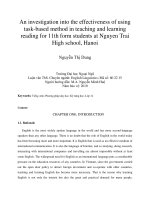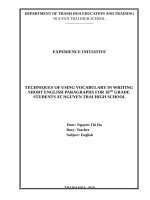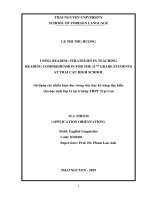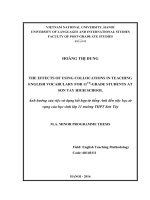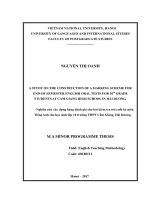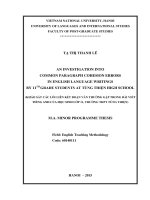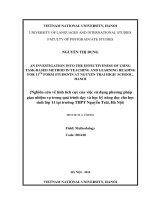Teaching english pronuciation (only voiced and voiceless sounds) for 11th grade students at nguyen khuyen high school graduation paper
Bạn đang xem bản rút gọn của tài liệu. Xem và tải ngay bản đầy đủ của tài liệu tại đây (949.3 KB, 51 trang )
HO CHI MINH CITY UNIVERSITY OF
FOREIGN LANGUAGES AND INFORMATION TECHNOLOGY
---o0o--DEPARTMENT OF FOREIGN LANGUAGES
GRADUATION PAPER
TEACHING ENGLISH PHONOLOGY (ONLY VOICED AND
VOICELESS SOUNDS) FOR 11th GRADE STUDENTS AT
NGUYEN KHUYEN HIGH SCHOOL
Instructor: M.A. Võ Ngọc Hân
Student: Lâm Mỹ Miều
School ID No.: 15DH710426
Class: SA1502
May 11th, 2019
ACKNOWLEDGEMENTS
“Enjoy the little things, for one day you may look back and realize they were big
things”
Kurt Vonnegut
This is to express my special thanks to the Department of Foreign
Languages of Ho Chi Minh City University of Foreign Languages –
Information Technology (HUFLIT) as well as my wonderful teacher - Vo Ngoc
Han who enabled me to grant the golden opportunity to carry this project on the
topic (Teaching English phonology (only voiced and voiceless sounds) for 11th
grade students at Nguyen Khuyen high school). It is her that provided me with all
the necessary facilities for the research. On top of that, her exemplary character,
constant encouragement, and careful monitoring, valuable feedbacks throughout the
research are so great that even saying my deepest appreciation is never enough. I
also had great pleasure working with Ms. Vo Thu Thuy, my English internship
mentor at Nguyen Khuyen high school. She is someone who was instrumental in
guiding English teaching for me. Thanks should also go to the two classes: 11L1
and 11B3, where I had time to work with during my memorable internship. I feel
very lucky to be able to work with them. I will never forget those days of mine at
Nguyen Khuyen high school. In addition, I would like to recognize the great support
that I received from my university friends, my parents, and my little sister. They
provided me with encouragement and patience throughout the duration of this
project by cheering me up. I very much appreciate them for helping me a lot in
gathering different information, strengthening my willpower from time to time in
making this project, even though I want to give up.
1
Table of Contents
ABSTRACT .................................................................................................. 4
CHAPTER 1: INTRODUCTION ................................................................ 5
1.1. Personal background ............................................................................ 5
1.2. Purpose of the study ............................................................................. 5
1.3. Research questions ............................................................................... 6
1.4. Contribution to knowledge ................................................................... 6
1.5. Structure of the report ........................................................................... 6
CHAPTER 2: LITERATURE REVIEW .................................................... 7
2.1. The Importance of Phonetics and Phonology in the Teaching of
Pronunciation .............................................................................................. 9
2.1.1 Phonetics Importance ...................................................................... 9
2.1.2. Phonology Importance ................................................................. 11
2.2. Vietnamese 11th grade pupils’ difficulties in learning English
phonology in textbook. .............................................................................. 12
2.3. Vietnamese students’ viewpoint on learning pronunciation ................ 15
CHAPTER 3: METHOD ........................................................................... 17
3.1. Setting ................................................................................................ 17
3.2. Participants ......................................................................................... 17
3.3. Data collection/ Method ..................................................................... 17
3.4. Data statistic ....................................................................................... 18
CHAPTER 4: RESULTS ........................................................................... 19
4.1. Results of questionnaire ..................................................................... 20
2
4.1.1. Background information ............................................................... 20
4.1.2. Perception of phonology instruction and acquisition .................... 22
4.2. Results of interview ............................................................................... 26
CHAPTER 5: DISCUSSION ..................................................................... 28
5.1. Discussions............................................................................................ 28
5.2. Limitations ............................................................................................ 28
5.3. Recommendations for further study ....................................................... 29
References ................................................................................................... 30
Appendix A ................................................................................................. 34
Appendix B ................................................................................................. 40
Appendix C ................................................................................................. 42
Appendix D ................................................................................................. 44
3
ABSTRACT
In accordance with a number of studies on English pronunciation for
Vietnamese people, many drawbacks are mentioned. There are so many problems to
list out like their mother language, their home country, and a lack of knowledge
about English phonetics, etc. Among those, this paper will give a close look on the
topic of Teaching phonology experienced by high school students. An aim of my
experiment was to determine if the learning pronunciation in English textbook
through phonetics teaching of Nguyen Khuyen High School’s students would be
good or bad. Total 90 participants who met criterion conducted the study through
either in questionnaires or in interviews. Findings indicated that the curiosity for
phonetics of both genders was explainable. An important factor in designing the
survey was the majority of female participants showed significantly intellectual
better understanding of phonetics than male participants. A sensitive analysis is
only related to one high school, and maybe it is not generalized to other high
schools in Ho Chi Minh City or even in Vietnam. The results of the modeling and
sensitivity analysis are presented, so they can be used as an aid to the design of
considerable research for those who are interested in the topic.
4
CHAPTER 1: INTRODUCTION
1.1. Personal background
By the time cultural meetings and tourism development have been
accomplished, English still places the most common superior language all over the
world for non-native speakers. In Vietnam, when it comes to teaching English
pronunciation for high school students, it is clearly a pain in the head for many ESL
teachers (refers to the teaching of English as a foreign language). To broaden this
view, phonetics is highly supported to teach beginners starting to speak English
from zero.
English phonetics, basic human speech sounds, plays an essential part in
real-life contexts due to the reflection of speakers’ gender identities and the nations
where they live in (Seidlhofer, 2001). Having a better concept of phonetics enables
learners acquire academic achievements and gets accessible to be promoted at work.
Although the Vietnam Ministry of Education and Training publicized a proposal in
2008 that turning foreign languages into a strong point for Vietnamese young
generation was beyond priority. However, this recommendation is still a hard test
for educators to figure out the solutions. Another suggested solution noted from
Nguyen Xuan Thanh, Deputy Director General of Secondary Education
Department, shared that a ten-year scaffolding English learning program (grade 3 to
12) was built to provide phonetics, pronunciation as well as four basic skills for
learners. Sadly, Shak, Lee and Stephen (2016) pointed out a series of difficulties in
Vietnamese students’ pronunciation of English.
1.2. Purpose of the study
The primary purpose of this study was to ascertain the effects of learning
phonetics of Nguyen Khuyen High School’s students. This mini – research was also
conducted to determine how many Nguyen Khuyen High School’s students favor or
even ignore to this section.
5
1.3. Research questions
The research topic takes a look at one main point: What is the importance of
teaching phonetics for high school students?
1.4. Contribution to knowledge
It is supposed that this topic will pave the way for the topic of the real essence of
teaching phonetics and how phonetics should be learnt and taught in textbook at
high schools in Vietnam. The needs must be popularized and reached out to all
educators and English learners like before. Providing that the investigation was
successfully carried out, high school students would be able to easily produce
sounds, words, or sentences without such concerns. On top of that, they would have
variety practice choices to test their speaking skills rather than doing a traditional
set of questions in an examination paper like before. Last but not least, the Vietnam
Ministry of Education and Training’s national English long-term plan will be
progressed well in the years to come after ten-year-long struggle decisions.
1.5. Structure of the report
The study commences with an introduction about phonetics effects on
students and this paper is broaden in the following chapter by a detailed analysis of
mistaken learning reasons which is the cornerstone of its issue. After outlining the
research findings and discussions, the study suggests ways of teaching and testing
phonetics effectively in the final chapter.
6
CHAPTER 2: LITERATURE REVIEW
When it comes to teaching Language Focus (LF) at high schools, many
English as a Second Language teachers (ESL teachers) complain that the amount of
time spent on designing one English lesson is not enough to transmit a full content
to students as planned. This scenario caused a lack of homogeneity due to the fact
that LF includes two parts: pronunciation and grammar. In an attempt to catch up
with a 45–minute-long lecture, some of them usually focus on instructing the
grammar section in a careful method for taking tests. Or else, they deliver the lesson
either the former or the later in a hurry which makes learners hard to understand the
main objectives of the lesson.
As has been mentioned above, the schools and ESL teachers put little
emphasis on oral interaction in different communicative contexts, typically
pronunciation–teaching phonology of sounds in LF. In the article of Tuoi Tre News
Online: “7 years at high school: Why unable to speak English?” posted on 12
October, 2006 strongly emphasized high school students’ fear of speaking English,
and even pointed out a shocking data of three-fourths (86.8%) of Vietnamese high
school students are not able to have English communication skills. The situational
irony is, after over a decade, Saigoneer published its article on Saturday, 06 January,
2018 in an online website headlined: “After 10 Years, Vietnam's National English
Project Still Struggles to Produce Results” to show discredit on foreign education
teaching plan as something “unpopular among schoolgoers”.
This issue literally reveals a sorrowful reflection of language education in
Vietnam not only in teaching English but also in teaching other foreign languages as
a whole. In the fields of language education, communicative approach became a
buzzword among educators. With this method of teaching oriented syllabus, it is
hoped that students will make good use of oral communication. However, Tam’s
research in January 2006 proved that the expectation is unsatisfied in comparison to
the reality since learners have been noticed with serious pronunciation errors
7
leading failure to communicate. The prominent problem lies in the fact that
traditional way of teaching English is still static and unchangeable, making students
stay inactive and demotivated in a test-taking environment rather than a
communication environment. In terms of English pronunciation teaching, it is
hypothesized that there will be some limitations to be improved by time. In addition,
in Tam’s research also cited from a book “On Tesol `80 Building Bridges: Research
and Practice” written by Janet C. Fisher. Relating to an accurate fluency criterion,
the mistake which might seriously weaken the progress of communication in ESL
learners is communication, rather than grammar or vocabulary. It is argued that
pronunciation is vital in developing the learners’ capabilities.
According to Davenport and Hannahs (1998) stated that there are various
ways for people to produce sounds. Therefore, sound is best described to use as “a
part of code of a particular language”. From this point of view, pronunciation is
seen as “the production and reception of sounds of speech”. Thus, sound is
meaningful because of its meaning usage in contexts. Here, the code is linked with
other elements to result in communication achievably. Meanwhile, if Vietnamese
learners’ needs and attitudes towards learning English pronunciation are taking into
account then the participants’ motivation and perspectives must be weighed and
examined. It is suggested to be a means to help Vietnamese teachers and educators
decide that are the appropriate teaching technique for the Vietnamese learners of
English. Therefore, this question arises: a) What is the importance of phonetics of
high school students? b) How do students feel about studying phonetics in
textbooks? c) What phonetics activities students enjoy when they get involved in
phonetics teaching? Once these questions are answered, there are many solutions
being available to the problem.
8
2.1. The Importance of Phonetics and Phonology in the Teaching of
Pronunciation
“Knowing a language includes knowing the sounds of that language”
Unknown
2.1.1 Phonetics Importance
In the previous decades, figuring out the most satisfactory methodology of
teaching the sounds of the foreign language is a nerve–racking for a number of ESL
teachers. One of the best approaches to the concern that has been recommended is
the use of the International Phonetic Alphabet (IPA). Trask’s (1996) dictionary
showed that the IPA targets to visualize “distinctive symbols for all speech sounds
which are phonologically distinct in any language”. Related to this advancement,
many versions of the IPA have been created and applied to be appeared in textbooks
for teaching pronunciation (e.g. O’Connor (1967)).
In the article “The Importance of Phonetics and Phonology in the Teaching
of Pronunciation” posted on 09 June 2016, Abdessamad Saidi said that phonetics
has made a fresh start to the teaching of pronunciation. With “the study of the
physical properties of sounds and their place and manner of articulation in the vocal
tract” (Broughton et. al. (1980: 50)), phonetics builds a teaching aid of dynamic
importance used in pronunciation’s teaching. An example to prove is that in
illustrative notes of the English sound system, linguists categorize speech sounds
into consonants and vowels. As stated in Haycraft (1978), the former are illustrated
to rely on “the movements of the mouth during the articulation (bilabial, dental,
alveolar, palatal, velar)” or rely on “the nature of the airstream, the place and
movement of the tongue, and also either the voice is used or not (voiced, voiceless,
plosive, affricate, fricative, nasal, lateral)”. On the contrary, vowels are primarily
labeled in the definition of “the position of the tongue and lip rounding”. These
element explanations are unseen to be “arbitrary” in the view of pronunciation’s
teaching. Haycraft (1978: 58) pointed out: “Awareness of this is useful as many
mistakes made by learners are due to slight differences in sound production”.
9
UNITIPA International Phonetic Alphabet (revised to 2018)
10
2.1.2. Phonology Importance
A recent book written by Phonology Richards & Schmidt (2010: 433)
involved phonology definition. It is “the study or description of the distinctive
sound units (phonemes) of a language and their relationship to one another”. One
problem with this term is that it concerns to differentiate “how phonemes and their
allophones operate in different phonological systems”. In the past, the phonology’s
research has observed a model change in the presentation of the smallest units of
phonological analysis. In addition, the model change creates two views in the name
of distinctive - feature analysis and structural analysis.
The central idea behind distinctive feature theory is “a feature of the sound
system of a language that serves as the crucial distinguishing mark between two
phonemes, as the distinctive feature of voicing”, following Dictionary.com. To
easily understand this statement, ELLO (English Language and Linguistics Online),
if two sounds are different, they cause “a distinction in meaning”. Once a feature
contrasts one phoneme to another, it is called a distinctive feature. This difference
also results in the meaning difference. This site also gives an example to clear its
opinion:
seal vs. zeal
What we can mark the differences between [s] and [z] are the distinctive
feature [voiced] sounds because [s] and [z] are two contrasting phonemes.
Moreover, they are unable to be used either allophones or complementary
distributions. Also, it is easy to notice them due to the distinguishable traits
[voicing]. According to their characteristics, the sounds of the language can be
assembled into groups.
Meanwhile, structural analysis is the process of making use of phonemes
which uses “familiar word parts (base words, prefixes, and suffixes) to determine
the meaning of unfamiliar words” (“lessonsense.com”, 2016). It is able to be
introduced to students to recognize the basic sound – letter relationships. Therefore,
the form is built by the structure of prefixes + root + suffixes.
11
Example 1: un+know+able, un+stop+able, un+control+able (same prefix,
same suffix).
Example 2: view, view+ing, re+view, re+view+ing, pre+view, pre+view+ed.
Example 3: liv+able, mov+ing, un+believ+able, pre+packag+ing
2.2. Vietnamese 11th grade pupils’ difficulties in learning English
phonology in textbook.
There are 4 sounds introduced to the lesson: /pt/, /bd/, /ps/, /bz/ in Part E:
Language Focus (Pronunciation), English 11 (Basic) - page 151. From that
introduction, the objective of the task is to let students understand how to produce
each sound appropriately. On the other hand, when preparing a lesson plan, the
difficulty of teaching pronunciation is unavoidable.
One of the apparent barriers that students usually overcome is “English final
consonant sound”. Tran (2005) shared his thoughts that: “Vietnamese phonology
seems more complicated than English, but in the long run, this system becomes
simpler and acquisitive than English”. He also commented: “it may take a non–
native speaker of Vietnamese two months to learn Vietnamese phonology
profoundly, and then he will surely be able to pronounce any Vietnamese word;
whilst British or American people during their whole life have to learn how to
pronounce new words continuously with a lot of support from dictionaries” (cited in
Thao’s translation, 2007). Having a sufficient input, typically the speaker’s tones,
Vietnamese learners are seen to be too confident to acquire phonetically. In fact, the
hypothesis above is not right because of this studying manner. That’s why,
Vietnamese native speakers have to cope with number of difficulties to learn
foreign languages which are the same and easy as their language to some extent, for
example, Russian, French, English or Spanish.
Surprisingly, there have been a large number of investigations on
Vietnamese’s difficulties in pronouncing English consonants and cluster. These
12
have given unexpected results, which become a precious material for advanced
studies, especially, for this paper.
Based on Ha’s information, (2005: 35 - 46) after investigating her findings
jumped to the conclusion on the left, in comparison with the table formed by Center
for Applied Linguistics (Neumann, 2007). Through Ha’s research, only the
Northern people have the problem with the confusion between /s/ and /ʃ/, /t / and /tʃ/,
/ʒ/ and /z/. Those units, which appeared in the table by Center for Applied
Linguistics (Neumann, 2007), are relevant for each Vietnamese learners as it
contains all the errors that Vietnamese speakers of any regions of the country can
make. Moreover, they are also persuasive to linguists who have certain knowledge
about Vietnamese dialects. Taking final sound into consideration, for instance, /θ/
and /ð/ at word – finally are commonly confused with /t/ and /d/ everywhere,
whereas /p/ sound in /pɒp/ (pop) is often mispronounced with /bɒp/ (Bob) by
Southern people and /ʃ/ sound in /pʊʃ/ (push) becomes /pʊs/ (puss) by Northern
people.
13
Tang (2007: 7) offers a comparison table below:
By showing the differences between Vietnamese and English consonant final
sounds, Ha (2007) found that Vietnamese learners often simplify or omit the
consonants in the final syllables of English words. He also noted that when
simplifying these final sounds, Vietnamese learners of English have a tendency to
replace the English endings with sounds that are common to both Vietnamese and
English languages (Tang, 2007, p.21).
Having noted the influence of the Vietnamese L1 on the production of
English, it is also important to understand the final syllable sounds that pose the
greatest struggle for Vietnamese English language learners (ELLs). Two sounds that
are not shared between the two languages as final consonant sounds are the alveolar
fricatives /s/ and /z/. While Vietnamese does have these sounds as syllable-initial
consonants, they never appear at the end of words (Tang, 2007). Ha (2005) asserts
that among Vietnamese speakers of English, the /z/ and /s/ sounds are most
14
frequently omitted. Vietnamese speakers’ also may pronounce /z/ as /s/. Another
sound, which is known to pose struggles for Vietnamese speakers, is the alveolar
lateral sound /t/.
2.3. Vietnamese students’ viewpoint on learning pronunciation
Although students-centered is being taken into action, when magnified it is
full of flaws and holes. Taking a close look at many public high schools in Vietnam,
it definitely assumes that passing the test in examinations is far important than
communicating English in class. Owning to many reasons listed such as: the period
teaching, the teacher’s accent, a rough way of teaching, students’ capabilities, and
bad facilities, etc. That would be no sense if not concentrating on how they feel.
Inefficient English speaking skill is lately has become a broad and current
interest on many educational websites, news and forums. In the article of
Tienphong/VNN: “Vietnamese students afraid to speak English”, this site expressed
educators’ concerns that Vietnamese people’ persona are effortlessly shamed when
making mistakes, since they have the negative grey opinions to be humiliated.
On top of that, however; whilst the speaking lessons, students are also
assigned to have a conversation with each other in English. Despite such mentioned
reasons above, students hardly have the golden opportunity to approach to modern
teaching aids. The only method students can do is to listen to teachers, “while
teachers do not make good pronunciations in all cases”. It may lead to the viewpoint
in Ha’s research in 2005 that an average number of fundamental words have been
mispronounced by pupils. On the other hand, they are believed that these
pronunciations were previously taught and acquired at high schools. Since they
have familiar with the way they learned English pronunciations, giving corrections
or feedbacks are not highly welcomed. In other words, giving students’ instructions
is regarded as something unnecessary and time-consuming at university.
15
The conventional methods of teaching have turned learners into the “passive
voice” when it comes to English learning. In contrast with communication ability,
students may just be able to be competent or great at grammar. They are on familiar
terms with grammar lessons taught at class. Hence, rough theories should be linked
with practical activities, otherwise the process of learning is probable on “the greasy
pole”.
16
CHAPTER 3: METHOD
3.1. Setting
This study took place at Nguyen Khuyen High School. It is a public high
school which is located at 50 Thanh Thai Street, Ward 12, District 10, Ho Chi Minh
City, Vietnam. Needless to say, Thanh Thai Street is not only a long, vibrant street
in general, but it is also well - known as “city-centered”.
3.2. Participants
From 09 March, 2019 to 23 March, 2019, 90 participants studying at the
Nguyen Khuyen High School were enrolled in the survey. Half of the participants
are from 11L1, whereas the others are from 11B3. They are 11th grade students
studying unspecialized English. Inclusion criteria reported that age between 16 and
17, agreement to study procedures, ability to provide answers and consent to survey
questions in English. Besides, along with questionnaires that would be given out to
respondents for the statistical representation of the findings in the study, and a
recorded clip with the respondents would also be conducted at school. Among the
participants joining in the study, they were all living in Ho Chi Minh City, and
confessed to have 5 English periods per school week. While the majority of
participants (55.6%) were female, the remaining participants were male.
3.3. Data collection/ Method
In order to collect data for the research, I designed a questionnaire with 15
questions, and provided a wordlist (Appendix B) and a sentence passage (Appendix
C). The former was created with Google Forms or printed in handouts, while the
later was recorded by mobile phone with respondents at least 6 minutes for each
person. Both were administered during March in 2019. Besides, 15 multiple choice
questions about the opinions of Nguyen Khuyen High School’s students toward
studying Part E: Language Focus – A. Pronunciation in textbooks (see Appendix
A), and the wordlist contained four sounds which ended with four final consonant
17
sounds that are foreign to Vietnamese speakers (/pt/, /bd/, /ps/, /pz/) (see Appendix
B).The sentence passage has 6 sentences and include the four target sounds from the
wordlist (see Appendix C). Both the wordlist and reading passage were included in
this study, and would be presented on the last page of this paper. When reading
from the wordlist, students would be aware of being evaluated on pronunciation and
therefore slowly enunciate each syllable. The pronunciation in the context of the
reading passage hoped to provide a more authentic representation of how the
speakers produce the words with less time to focus on each syllable.
3.4. Data statistic
After collecting all the answers to the questionnaire and a two-week
interview, quantitative and qualitative method would be carried out. Firstly,
quantitative method would focus on a number of students spent time on reviewing
the pronunciation section based on gender (see in Chapter 4: Figure 1, and Table 1)
and reasons to review it (see in Chapter 4: Figure 2). This method was able to
collect the data quickly, however; results might be sometimes superficial dataset
and hard to draw broad conclusions in context. Secondly, two methods as
mentioned above would combine together so as to find out participant’s points of
view and their concerns about pronunciation difficulties (see in Chapter 4: Figure 3,
and Table 2). Then, the datasets were calculated the proportions of all respondents
answering in each category by Excel spreadsheet.
18
CHAPTER 4: RESULTS
Of 90 survey samples, the majority of participants all agree the importance of
studying English phonology. Typically, Nguyen Khuyen high school’s students are
main study participants aged from 16 to 17, and are living in Ho Chi Minh City.
Approximately 51.1% and 48.9% of females and males were participated in this
survey during 2 weeks from 09 March, 2019 through 23 March, 2019.
It appears that all questions in Appendix A are open-ended ones employed in
my survey, while Appendix B, C, and D with 5 students participating in the survey
through recording videos and a face-to-face interview. The data collection would be
carried out in both quantitative and qualitative methods. The former data were
calculated by means of Excel, whereas descriptive statistical analyses were
performed in this research.
19
4.1. Results of questionnaire
4.1.1. Background Information
30%
> 5 years old
70%
> 10 years old
Figure 1: The age of learning English
Figure 1 provides information about the ideal age of Nguyen Khuyen High
School’s students towards learning English experience from two different phases.
Overall, it is clear that most of participants have begun studying English since they
were primary students, reaching the highest figure of 70%. Meanwhile, the
remaining who admitted to approach English later than the majority ones as it is a
compulsory subject at secondary schools obtained 30%. Given from the graph, the
young age to acquire English was literally high.
20
Issues
Responses
Number of
Percentage of
learners’
learners’
responses
responses
Current English
1= poor
15
16.7%
pronunciation
2= neutral
30
33.3%
skills
3= good
25
27.8%
(self – evaluated)
4= excellent
20
22.2%
Desire for English
Yes
88
97.8%
No
2
2.2%
Yes
8
8.9%
No
82
91.1%
pronunciation
improvement
Attending English
classes in language
institution
Table 1: Data analysis of the learners’ attitudes towards their English pronunciation
Besides, Table 1 illustrates the number of learner participants’ evaluation on
English pronunciation. It is worthy to acknowledge that there are 30 people who
responded their English pronunciation skills are “neutral”. Another positive thing to
note is that more than haft of respondents were earnestly eager for current
pronunciation improvements. And this proportion attained to the figure of 97.8%. In
addition, they were of the opinion that to have a good pronunciation skill would
better them to communicate well in English. On the other hand, looking at the
number of students has attended English classes in language institutions, a “No”
answer was outweighed a “Yes” answer with 91.1% and 8.9% correspondingly.
Overall, the table presents a full overview of the answers given by the participants.
21
4.1.2. Perception of phonology instruction and acquisition
Never
10.9%
9%
Female
Male
> 5 minutes
6.5%
18.2%
3-5 minutes
82.6%
61.4%
Figure 2: Number of times spent on self-studying English pronunciation
Meanwhile, the comparison with the amount of time spent on revision taught
English pronunciation by both genders is revealed in figure 5. Through paper
questionnaire, 82.6% of boys showed sufficient time to review vocabulary including
pronunciation meaning and how it is transcribed, whereas 61.4% of girls paid
attention to this. When the question was asked unless spending less than 5 minutes,
the former gained 6.5% and the figure of the later was 18.2%. Also, the other
responded the answer “Never” for revising previous knowledge should be seriously
born in mind with 9% and 10.9% corresponding for boys and girls. The amount of
time used toward learning English pronunciation at home among males was
worrying especially in the context of the attitude of self-education was higher than
that of in women. In general, boys should be encouraged to self-review the lesson.
This would increase the chance to enhance the lesson well and score higher in
examination.
22
50%
45%
40%
35%
30%
25%
20%
15%
10%
5%
0%
45.6%
22.2%
21.1%
11.1%
A native-like
accent
Overall
Suprasegmental Segments (i.e.
intelligibility of a aspects (e.g.,
vowels and
speaker in
rhythm, stress consonants. E.g.,
English
and intonation)
meet /miːt/)
communication
Figure 3: The concern to English communication acquisition
Needless to say, figure 3 shows four main worries when to study English
pronunciation among Nguyen Khuyen High School’s students. As can be seen from
the chart, the most crucial aspect that learners paid attention to in English
pronunciation was the possibility to accomplish an understandable conversation
(45.6%). In addition, from figures of about 11.1%, 21.1% and 22.2% among
surprising factors with the concerns such as the native-like accent, the segments and
the suprasegmental features respectively were given as less important aspect for the
general acquiring English communication by students.
23
According to Table 2 below, the vast majority of those who replied the
questions to their situations were so apparently. It is clear that ESL teacher did have
a strong influence on the acquisition of pronunciation skills. Typically, 58.9% of the
participants agreed that ESL teachers affected students’ pronunciation learning to
some extent. And 33.3% of them admitted with the statement that the learning
pronunciation process is highly impacted by their ESL teachers.
Issues
Responses
Number of
Percentage of
learners’
learners’
responses
responses
Do teachers’
1= not at all
0
0%
pronunciation
2= not much
7
7.8%
skills influence on
3= fairly
53
58.9%
4= very
30
33.3%
learners’
pronunciation
achievement?
Table 2: The impact of ESL teachers on learners’ pronunciation achievement rated by
students
In order to help students develop the ability of better English pronunciation,
potential solutions to the problem were recommended and they were asked to rate
for these suggestions. The percentage points of this question are calculated and
pointed out in Table 3 below.
24

